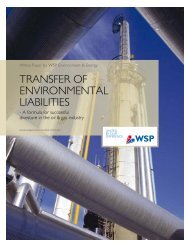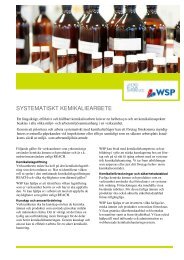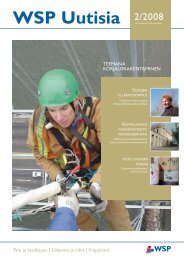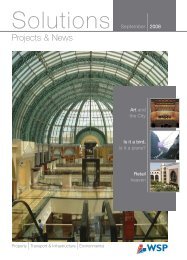Projects & News - WSP Group
Projects & News - WSP Group
Projects & News - WSP Group
- No tags were found...
Create successful ePaper yourself
Turn your PDF publications into a flip-book with our unique Google optimized e-Paper software.
In February, the US Houseof Representatives votedto kick start the nation’seconomy with a $787.2billion stimulus package,the country's biggestspending plan sincePresident Roosevelt'sNew Deal in the 1930s.What do these measuresmean for <strong>WSP</strong> <strong>Group</strong>’sAmerican companies?Despite the new regime being an eraof firsts – the first black president, the firsttruly urban president – the initiatives areas much about cleaning up the oldas bringing in the new. They recognisethat in order to support a healthy economy,the current infrastructure needsimmediate updating. Urban brownfieldsites will be redeveloped and America’sinventory of public buildings willbe refurbished after decades of neglect.According to David Cooper, CEOof <strong>WSP</strong> Flack + Kurtz, this also meansthe greening of existing governmentbuildings – schools, courthouses andcity halls – to reduce their carbonfootprint and make them energyefficient. “In keeping with the Obamaadministration’s focus on climate change,a substantial amount of stimulus moneyis being made available for the upgrade,modernisation and greening of publicbuildings. Energy efficiency andsustainability have been the cornerstoneof our practice for the past 30 years, butto date, the public sector has contributedonly 20% of our overall business.That’s likely to increase significantly.”He acknowledges that the stimuluspackage cash does not mean theindustry is suddenly on Easy Street.“It’s a very tough climate to competein and winning work will be very feedriven. But <strong>WSP</strong> Flack + Kurtzis in a good position; we havea great portfolio of public work,relationships with relevant agencies,great sustainability credentials anda strong engine to deliver our services.”There will also be a revitalisation of thetransport infrastructure, with $18 billionallocated to roads and bridges and$8 billion to high speed rail transit.About 10% of this money hasto be spent in 2009 and a further 60%A substantialamount ofstimulus moneyis being madeavailable forthe upgrade,modernisationand greeningof public buildingsin 2010. <strong>WSP</strong> SELLS is well positionedto benefit from the spending plan and hasalready had three of its on-call publicsector engineering contracts increasedby a total of $6 million to assist Stateagencies in performing stimulus work.CEO Steven Smith says: “Getting themoney into the system as earlyas possible is vital to get the economymoving. The injection of governmentmoney will in turn free up private fundingfor other projects.” He points out thatthe preparation process to identifyprojects that meet criteria for thestimulus money has been going on forup to nine months, and constructionwill probably extend into 2012.“It’s an investment in the country’sfuture. The work will generate jobs andhelp get the economy moving. From ourperspective it’s already been positivebecause work has come to us thatwe wouldn’t otherwise have.”Chris Jones, Director of <strong>WSP</strong>Environment & Energy believes that thecommitment of Obama to the creationof a ‘green’ economy also representsa major growth opportunity forThe Obama effectcompanies operating in the privatesector, although he cautions that“Policy makers must balance the urgentneed to stabilise the economy witha commitment to addressing the longerterm strategic policies and goalsset out by the new president.”To tackle climate change, followingCalifornia’s lead, Obama is promotinglegislation that will implementan economy-wide cap and tradeprogram, committing the US to reducingcarbon emissions by 80% below 1990levels by 2050. The recently approvedAmerican Recovery and ReinvestmentAct also signals Obama’s intentto promote energy independencethrough clean and renewable energytechnologies, as well as major upgradesto transmission and distribution systems.Jones believes that <strong>WSP</strong> Environment& Energy is well placed to capitaliseon these opportunities, citing <strong>WSP</strong>’sstrengths in corporate greenhousegas and energy management, greenbuildings, clean and renewable energytechnologies and the company’sexperiences with cap and tradein Europe. “But while the long termprospects for the sector in the US areundoubtedly good, current economicconditions will make for a toughoperating environment in 2009.”Jones concurs with David Cooper’sview that the greening of governmentbuildings is a major opportunity for <strong>WSP</strong>.“The Federal government is by far thebiggest owner and occupier of realestate in the US, so when it takes actionto ‘green’ its properties, the rest of thesector sits up and takes notice.”10

















